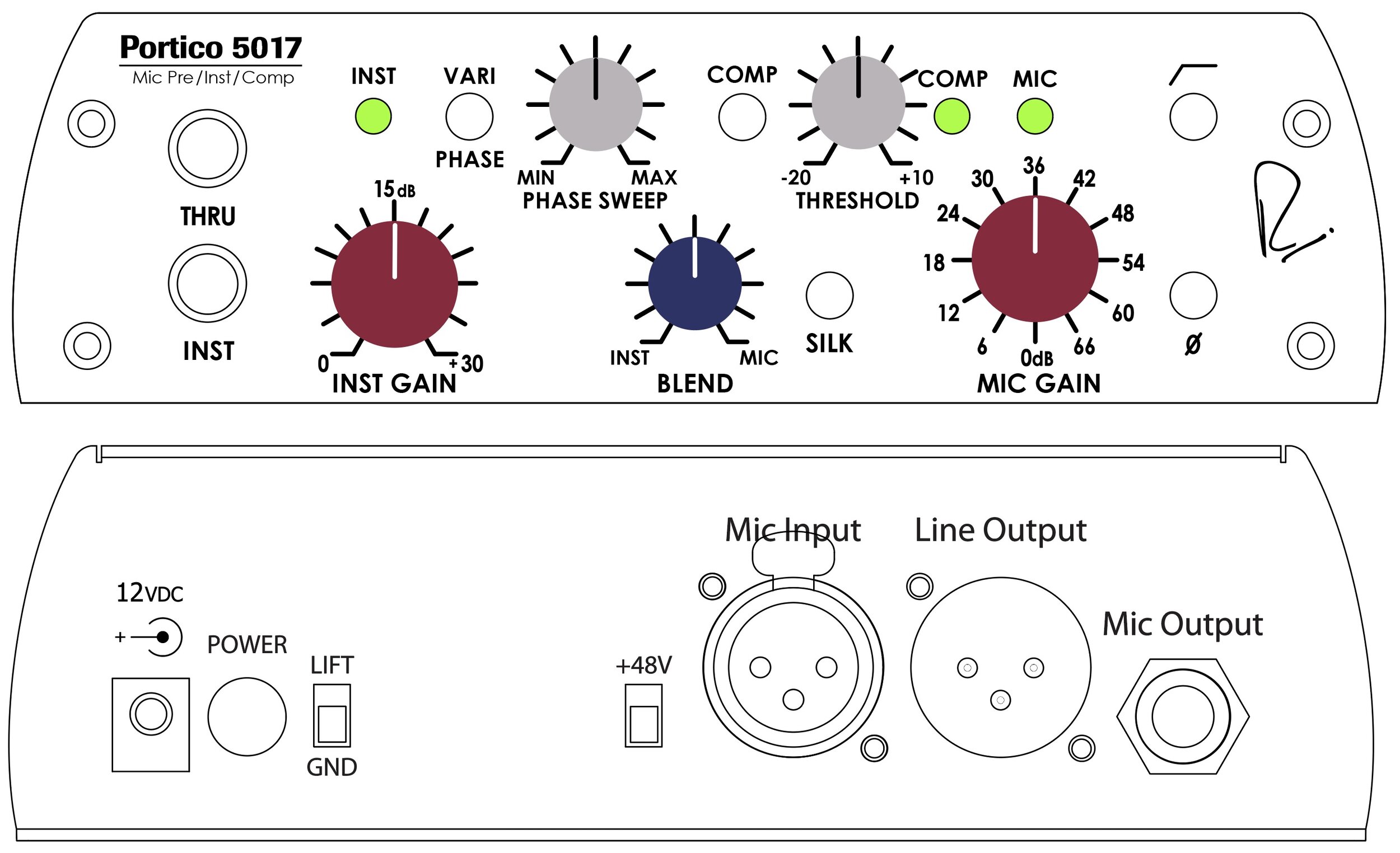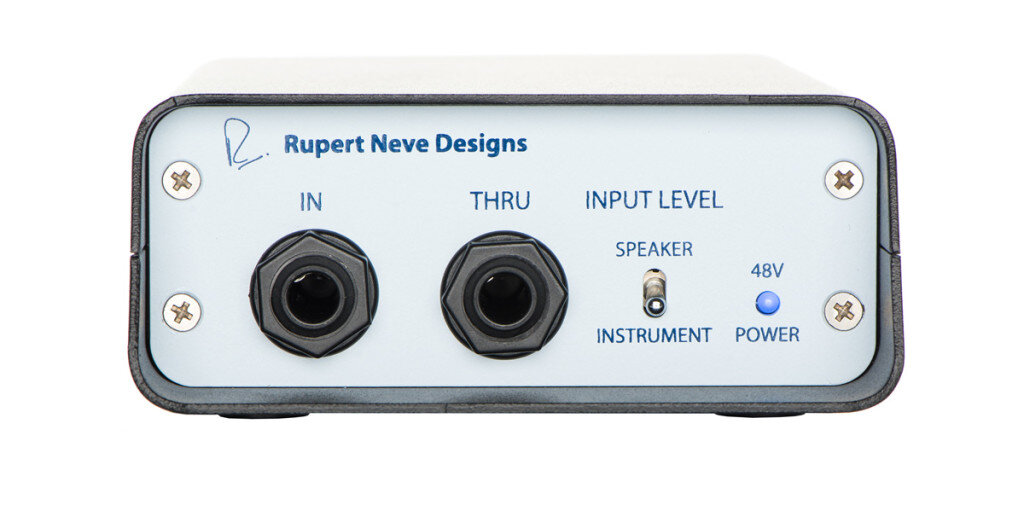
5017
Mobile Mic Pre / DI / Compressor
OVERVIEW / MEDIA / FEATURES / REVIEWS / SPECS & RESOURCESClassic tone and control on the go.
Comprised of a rugged, portable chassis with world-class preamp, compressor and DI circuits as well as two channel operation, Vari-phase, Silk and DI/mic blending capabilities, the Portico 5017 is an innovative and powerful tool for recording or live performance.

“...the most versatile and portable piece of gear I have, not to mention it sounds amazing in addition to the practicality.”
TWO CHANNEL OPERATION
With two transformer coupled outputs, the 5017 has separate line outputs for the DI/Blend and Mic signals when the blend control is set to fully DI. The mic output is always independent.
SILK
Pushing the Silk button engages the Silk circuit, which enhances the source’s harmonic content in a manner very reminiscent of many of Rupert’s class-A vintage designs.
MIC GAIN
A 12-way precision rotary switch covering Line (0) and Mic from 0 to 66 dB in 6 dB steps.
INST GAIN
Continuous gain control from 0dB to 30dB.
THRU & INST 1/4” PHONE JACKS
Balanced or unbalanced Hi-Z input for instruments, with a THRU output to send signal to an amplifier.
+48V PHANTOM POWER
Provides 48V phantom power to microphones. Controlled by a switch on the back of the unit.
HIGH PASS FILTER
The high pass filter is a valuable aid in any signal chain, but particularly so in a microphone preamplifier. Signals below 80Hz can be attenuated at a rate of 12db / octave, getting rid of building rumble, motor hum, etc.
POLARITY
Push button inverts the polarity of the mic input signal path. The symbol “Ø” is often used to denote opposite polarity.
VARI-PHASE
When engaged, the VARI-PHASE control rotates the phase incrementally, allowing two signals with the same source to be phase aligned. This control is most apparent when the signals being combined are at roughly equal levels, and is generally used when blending an instrument’s direct signal with its amplified signal, as captured by a microphone.
THE COMPRESSOR
Based around a new LDR (light dependent resister) design, the 5017’s opto-coupler compressor has been simplified to a single threshold control with auto make up gain. By default, the compressor is set to a fixed 2:1 ratio with fixed attack and release. To set the compressor, simply dial the threshold control down until the desired amount of compression is achieved. An LED light indicates when the compressor is active.
INDICATORS
Indicators on the 5017 denote signal presence and clipping on both DI and mic signals, as well as compressor activation.
INTERNAL JUMPERS
Two internal jumpers in the 5017 can be set to change the compressor from the mic channel to the DI / blend channel, and to change the compressor time constant from standard to fast.
REVIEWS
“The Portico 5017 was a Swiss army knife of audio solutions, making both acoustic and electric guitars sound better. The Compressor and Silk controls were icing on the cake; the Blend feature is perfect for guitarists who know the magic of microphones.”
Vintage Guitar
“The Portico 5017 is the most versatile and portable piece of gear I have, not to mention it sounds amazing in addition to the practicality. Even better is it doesn’t hurt the wallet.”
Adrian Quesada
Black Pumas, Groupo Fantasma
“This thing sounds really good! It saved my a$$ a bunch of times on a recent European tour.”
Jim Devito
“For novices seeking their first quality piece, I recommend this little, humble utilitarian over a rack full of brittle mic pres and mushy compressors….For high-fidelity loving, traveling musician/self-recordists, the 5017 is a must have.”
Rob Tavaglione

SPECIFICATIONS & DOWNLOADS
FREQUENCY RESPONSE
Main Output, no load.
-0.2 dB @ 10 Hz
-3 dB @ 160 kHz
NOISE
Measured at Main Output, unweighted, 22 Hz - 22 kHz. Terminated 150 Ohm.
With gain at unity better than -100 dBu
With gain at 66 dB better than -62 dBu
Equivalent Input Noise better than -128 dBu
NOISE FACTOR
1.5 dB
HIGH PASS FILTER
80 Hz, 12 dB/Octave Bessel
MAXIMUM OUTPUT LEVEL
Maximum output from 20 Hz to 40 kHz is +23 dBu
TOTAL HARMONIC DISTORTION AND NOISE
@ 1 kHz, +20 dBu output: Main Output: Better than 0.001%
@ 20 Hz, +20 dBu output: Main Output: Better than 0.002%
SILK ENGAGED
Better than 0.2% Second harmonic
COMPRESSOR
THRESHOLD
Continuously Variable from -20 dBu to +10 dBu
RATIO
Fixed at 2:1
ATTACK & RELEASE
FAST MODE: Attack 40ms , Release 40ms
SLOW MODE: Attack 100ms , Release 350ms
PHANTOM POWER
+48 Volts DC +/- 1%
POWER REQUIREMENTS
12VDC is optimal voltage, but 9-15VDC is acceptable
CURRENT CONSUMPTION
@ 9VDC Current is 1.3 A typical: Power = 11.7W
@ 12VDC Current is 1.0 A typical: Power = 12.0 watts
@ 15VDC Current is 800 mA typical: Power = 12.0 watts
DIMENSIONS
7.5″ (deep) x 6.5″ (wide) x 2″ (high)
FREQUENTLY ASKED QUESTIONS
While the amplifiers are similar, the 5017 has a transformerless input stage and the line amplifiers run on lower voltages with slightly lower headroom, due to the inherent limitations of the power supply. The performance of the 5017 is still excellent however.
No, the RNDI is a unique design.
The compressor LED does not turn on merely by engaging the compressor switch: it turns on when the circuit is actively compressing, and the compressor is active when the signal rises above the set threshold. So, lower threshold = more compression = LED on.
If you aren't getting compression with the threshold all the way down, make sure you have added enough gain to your signal, and also that the Blend control is set fully to the signal (or mix of signals) you are looking to compress.






